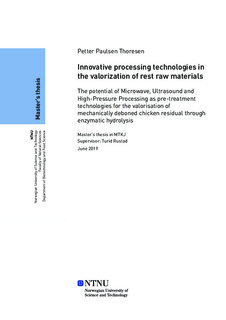| dc.description.abstract | Enzymatisk hydrolyse av restråstoff er en mild, ikke-giftig og spesifikk strategi for utnyttelse av proteinkilder man tidligere ikke har muliggjort seg av. En slik prosess vil danne peptider som kan benyttes i ulike produkter og sammenhenger og kan på den måten føre til økt verdiskapning samtidig som mengden avfall reduseres. Mens enzymatisk hydrolyse er en prosess som egner seg godt for maksimal verdiøkning av restråstoff, er prosessen ofte forbundet med lang behandlingstid og begrensede utbytter. Innovative teknologier som høy-trykksbehandling (HPP), mikrobølger (MW) og ultralyd (US), kan imidlertid bidra til å redusere de begrensningene som ofte er forbundet med enzymatisk hydrolyse. Dette gjennom å øke enzymets tilgjengelighet til substratene i restråstoffet gjennom å endre råstoffets strukturelle egenskaper, men også gjennom å endre substratenes struktur gjennom protein denaturering. På denne måten kan bruken av innovative teknologier som en forbehandling før enzymatisk hydrolyse forbedre tekno-funksjonelle og helsefremmende egenskaper samt øke utbyttet knyttet til prosessen.
Målet med denne oppgaven var å undersøke det potensialet innovative teknologier (MW; US; HPP) har for å øke bioaktive og funksjonelle egenskaper hos hydrolysat produsert gjennom enzymatisk hydrolyse av reststoff fra mekanisk utbeinet kylling.
Dette ble gjennomført ved å benytte MW, US og HPP som forbehandling av reststoff fra mekanisk utbeinet kylling og deretter gjennomføre enzymatiske hydrolyser ved hjelp av et industrielt relevant enzym. Etter enzym inaktivering (95 ℃; 15 min) ble reaksjonsmediet separert til en filtrert væskefase, en lipid fase, en fast fase, en partikkel fase og en multikomponent fase. Vekten av alle fasene for de ulike eksperimentene ble målt. Protein konsentrasjonen ble målt gjennom hydrolysen (0.5, 5, 15, 30 og 60 min), det sammen gjelder protein konsentrasjonen i det totale inaktiverte hydrolysevolumet (FHV). For spesifikke teknologier og innstillinger ble FHV videre brukt for å beregne protein løselighet ved pH 2, 4, 6 og 11, samt DPPH radical scavenging activity (antioksidant egenskaper) ved proteinkonsentrasjoner 0.5, 1, 2, 4 og 6 mg/mL.
De undersøkte teknologiene viste seg å presentere spesifikke fordeler med tanke på egenskapene til hydrolysatet. Dersom det er ønskelig å produsere et hydrolysat med økt protein konsentrasjon (etter 60 min) burde HPP benyttes med et trykk på 400 MPa eller høyere (15 min; 25 ℃). Det beste valget for å produsere et hydrolysat med høy DPPH radical scavenging activity (4 og 6 mg/mL) ble oppnådd vha. US og en forbehandling med effekt på 900 W (30 min, T < 30 ℃). Dersom det er ønskelig å produsere et hydrolysat med økt protein løselighet over pH kan dette oppnås både med MW og HPP. MW tilbyr imidlertid den raskeste veien med en behandlingstid på 1 min (40 ℃; 2.45 GHz) i motsetning til å benytte HPP (200 MPa) hvor det er nødvendig med en behandlingstid på 15 min.
Bortsett fra de nevnte anbefalingene presenterer flere av teknologiene hydrolysater i stand til å interagere med lipider. En US-behandling på 600 W (30 min, T < 30 ℃) og en MW-behandling på 1 min (40 ℃; 2.45 GHz) virker begge å indusere dannelsen av peptider med økte lipid interagerende egenskaper. Dette gjelder også HPP ved 200 MPa (15 min; 25 ℃) som i tillegg tilbyr antioksidant-egenskaper (4 mg/mL). | |
| dc.description.abstract | Enzymatic hydrolysis of food processing by-products is a gentle, non-toxic and highly specific strategy for utilization of unexploited protein sources into added-value peptide-rich formulations, towards mitigation of food waste footprint. However, mild treatment conditions, better suited for such high-value applications, are often associated to long processing times and limited extraction yields. Innovative technologies, such as high-pressure processing (HPP), microwave heating (MW) and sonication (US), can contribute to the valorisation of food residuals through enzymatic hydrolysis by enhancing the availability of cleavage sites through biomatrix restructuration and protein unfolding. Thus, the resulting hydrolysates exhibit improved/standard techno-functionality and health-promoting effects, besides higher process yields.
The objective of this work was to investigate the potential of innovative technologies (MW; US; HPP) to enhance the bioactive and functional properties of the hydrolysates obtained from enzymatically hydrolysed mechanically deboned chicken residual (MDCR).
In the present study, this was conducted by applying MW, US and HPP as pre-treatments of mechanically deboned chicken residual (MDCR) prior to enzymatic hydrolysis using an industrially relevant enzyme. After enzyme inactivation (95 ℃; 15 min), the hydrolysis reaction media was separated into a filtered aqueous, lipid, solid, particulate and a semi-solid multicomponent phase. The weight of all phases was recorded for the different experimental conditions. The protein concentration in the hydrolysates at 0.5, 5, 15, 30 and 60 min of hydrolysis and in the total reaction volume after hydrolysis (FHV) was determined. For the FHV of specific trials, the protein solubility of the hydrolysate at pH 2, 4, 6 and 11 was determined, as well as the DPPH radical scavenging (antioxidant) activity at protein concentrations of 0.5, 1, 2, 4 and 6 mg/mL. The investigated technologies present specific advantages with regards to the hydrolysate properties. In order to produce hydrolysates with increased protein concentration (after 60 min of hydrolysis), HPP should be applied at pressures of 400 MPa or higher (15 min; 25 ℃). The best option for enhanced DPPH radical scavenging activity (4 and 6 mg/mL protein concentration) would be US pre-treatment at 900 W (30 min, T < 30 ℃). Finally, hydrolysates with increased protein solubility over pH could be achieved with a microwave treatment of 1 min (40 ℃; 2.45 GHz) or HPP treatment, however longer treatment times would be needed (15 min). Apart from the mentioned recommendations the results suggest that several of the technologies hold the potential to induce the formation of peptides with enhanced functionality apart from protein solubility. A US pre-treatment at 600 W (30 min, T < 30 ℃) and a MW pre-treatment for 1 min (40 ℃; 2.45 GHz) seem to hold the potential of inducing the formation of peptides with higher lipid associating properties, as does HPP treatments at 200 MPa (15 min; 25 ℃) which also present antioxidant properties (4 mg/mL). | |
